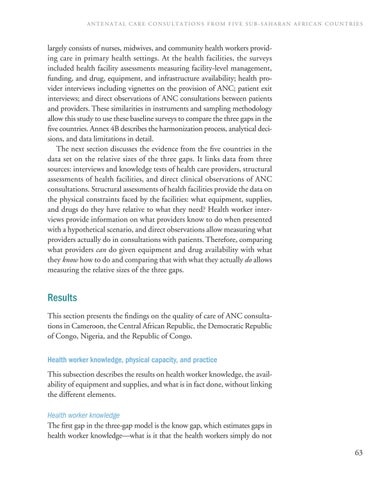A ntenatal C are C onsultations from F ive S ub - S aharan A frican C ountries
largely consists of nurses, midwives, and community health workers providing care in primary health settings. At the health facilities, the surveys included health facility assessments measuring facility-level management, funding, and drug, equipment, and infrastructure availability; health provider interviews including vignettes on the provision of ANC; patient exit interviews; and direct observations of ANC consultations between patients and providers. These similarities in instruments and sampling methodology allow this study to use these baseline surveys to compare the three gaps in the five countries. Annex 4B describes the harmonization process, analytical decisions, and data limitations in detail. The next section discusses the evidence from the five countries in the data set on the relative sizes of the three gaps. It links data from three sources: interviews and knowledge tests of health care providers, structural assessments of health facilities, and direct clinical observations of ANC consultations. Structural assessments of health facilities provide the data on the physical constraints faced by the facilities: what equipment, supplies, and drugs do they have relative to what they need? Health worker interviews provide information on what providers know to do when presented with a hypothetical scenario, and direct observations allow measuring what providers actually do in consultations with patients. Therefore, comparing what providers can do given equipment and drug availability with what they know how to do and comparing that with what they actually do allows measuring the relative sizes of the three gaps.
Results This section presents the findings on the quality of care of ANC consultations in Cameroon, the Central African Republic, the Democratic Republic of Congo, Nigeria, and the Republic of Congo. Health worker knowledge, physical capacity, and practice This subsection describes the results on health worker knowledge, the availability of equipment and supplies, and what is in fact done, without linking the different elements. Health worker knowledge The first gap in the three-gap model is the know gap, which estimates gaps in health worker knowledge—what is it that the health workers simply do not 63

